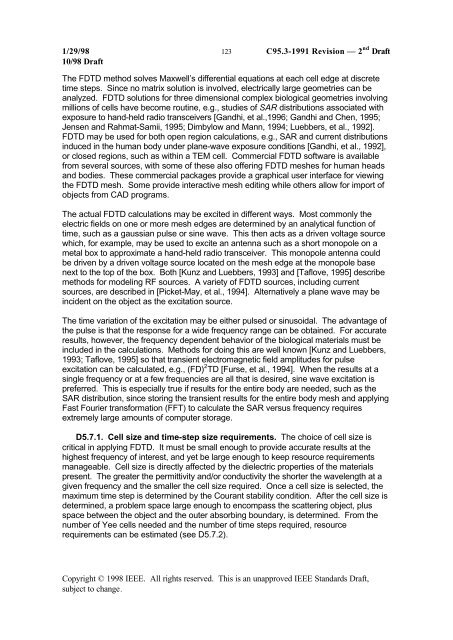DRAFT Recommended Practice for Measurements and ...
DRAFT Recommended Practice for Measurements and ...
DRAFT Recommended Practice for Measurements and ...
Create successful ePaper yourself
Turn your PDF publications into a flip-book with our unique Google optimized e-Paper software.
1/29/98 123 C95.3-1991 Revision — 2 nd Draft<br />
10/98 Draft<br />
The FDTD method solves Maxwell’s differential equations at each cell edge at discrete<br />
time steps. Since no matrix solution is involved, electrically large geometries can be<br />
analyzed. FDTD solutions <strong>for</strong> three dimensional complex biological geometries involving<br />
millions of cells have become routine, e.g., studies of SAR distributions associated with<br />
exposure to h<strong>and</strong>-held radio transceivers [G<strong>and</strong>hi, et al.,1996; G<strong>and</strong>hi <strong>and</strong> Chen, 1995;<br />
Jensen <strong>and</strong> Rahmat-Samii, 1995; Dimbylow <strong>and</strong> Mann, 1994; Luebbers, et al., 1992].<br />
FDTD may be used <strong>for</strong> both open region calculations, e.g., SAR <strong>and</strong> current distributions<br />
induced in the human body under plane-wave exposure conditions [G<strong>and</strong>hi, et al., 1992],<br />
or closed regions, such as within a TEM cell. Commercial FDTD software is available<br />
from several sources, with some of these also offering FDTD meshes <strong>for</strong> human heads<br />
<strong>and</strong> bodies. These commercial packages provide a graphical user interface <strong>for</strong> viewing<br />
the FDTD mesh. Some provide interactive mesh editing while others allow <strong>for</strong> import of<br />
objects from CAD programs.<br />
The actual FDTD calculations may be excited in different ways. Most commonly the<br />
electric fields on one or more mesh edges are determined by an analytical function of<br />
time, such as a gaussian pulse or sine wave. This then acts as a driven voltage source<br />
which, <strong>for</strong> example, may be used to excite an antenna such as a short monopole on a<br />
metal box to approximate a h<strong>and</strong>-held radio transceiver. This monopole antenna could<br />
be driven by a driven voltage source located on the mesh edge at the monopole base<br />
next to the top of the box. Both [Kunz <strong>and</strong> Luebbers, 1993] <strong>and</strong> [Taflove, 1995] describe<br />
methods <strong>for</strong> modeling RF sources. A variety of FDTD sources, including current<br />
sources, are described in [Picket-May, et al., 1994]. Alternatively a plane wave may be<br />
incident on the object as the excitation source.<br />
The time variation of the excitation may be either pulsed or sinusoidal. The advantage of<br />
the pulse is that the response <strong>for</strong> a wide frequency range can be obtained. For accurate<br />
results, however, the frequency dependent behavior of the biological materials must be<br />
included in the calculations. Methods <strong>for</strong> doing this are well known [Kunz <strong>and</strong> Luebbers,<br />
1993; Taflove, 1995] so that transient electromagnetic field amplitudes <strong>for</strong> pulse<br />
excitation can be calculated, e.g., (FD) 2 TD [Furse, et al., 1994]. When the results at a<br />
single frequency or at a few frequencies are all that is desired, sine wave excitation is<br />
preferred. This is especially true if results <strong>for</strong> the entire body are needed, such as the<br />
SAR distribution, since storing the transient results <strong>for</strong> the entire body mesh <strong>and</strong> applying<br />
Fast Fourier trans<strong>for</strong>mation (FFT) to calculate the SAR versus frequency requires<br />
extremely large amounts of computer storage.<br />
D5.7.1. Cell size <strong>and</strong> time-step size requirements. The choice of cell size is<br />
critical in applying FDTD. It must be small enough to provide accurate results at the<br />
highest frequency of interest, <strong>and</strong> yet be large enough to keep resource requirements<br />
manageable. Cell size is directly affected by the dielectric properties of the materials<br />
present. The greater the permittivity <strong>and</strong>/or conductivity the shorter the wavelength at a<br />
given frequency <strong>and</strong> the smaller the cell size required. Once a cell size is selected, the<br />
maximum time step is determined by the Courant stability condition. After the cell size is<br />
determined, a problem space large enough to encompass the scattering object, plus<br />
space between the object <strong>and</strong> the outer absorbing boundary, is determined. From the<br />
number of Yee cells needed <strong>and</strong> the number of time steps required, resource<br />
requirements can be estimated (see D5.7.2).<br />
Copyright © 1998 IEEE. All rights reserved. This is an unapproved IEEE St<strong>and</strong>ards Draft,<br />
subject to change.
















